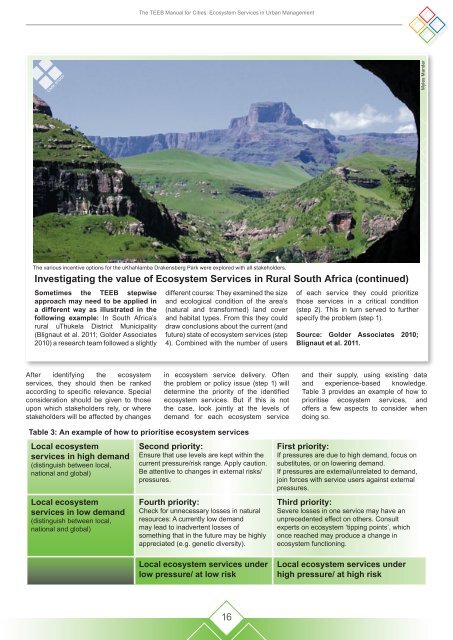TEEB Manual for Cities
TEEB Manual for Cities
TEEB Manual for Cities
You also want an ePaper? Increase the reach of your titles
YUMPU automatically turns print PDFs into web optimized ePapers that Google loves.
The <strong>TEEB</strong> <strong>Manual</strong> <strong>for</strong> <strong>Cities</strong>: Ecosystem Services in Urban ManagementMyles ManderThe various incentive options <strong>for</strong> the uKhahlamba Drakensberg Park were explored with all stakeholders.Investigating the value of Ecosystem Services in Rural South Africa (continued)Sometimes the <strong>TEEB</strong> stepwiseapproach may need to be applied ina different way as illustrated in thefollowing example: In South Africa’srural uThukela District Municipality(Blignaut et al. 2011; Golder Associates2010) a research team followed a slightlydifferent course: They examined the sizeand ecological condition of the area’s(natural and trans<strong>for</strong>med) land coverand habitat types. From this they coulddraw conclusions about the current (andfuture) state of ecosystem services (step4). Combined with the number of usersof each service they could prioritizethose services in a critical condition(step 2). This in turn served to furtherspecify the problem (step 1).Source: Golder Associates 2010;Blignaut et al. 2011.After identifying the ecosystemservices, they should then be rankedaccording to specific relevance. Specialconsideration should be given to thoseupon which stakeholders rely, or wherestakeholders will be affected by changesin ecosystem service delivery. Oftenthe problem or policy issue (step 1) willdetermine the priority of the identifiedecosystem services. But if this is notthe case, look jointly at the levels ofdemand <strong>for</strong> each ecosystem serviceand their supply, using existing dataand experience-based knowledge.Table 3 provides an example of how toprioritise ecosystem services, andoffers a few aspects to consider whendoing so.Table 3: An example of how to prioritise ecosystem servicesLocal ecosystemservices in high demand(distinguish between local,national and global)Local ecosystemservices in low demand(distinguish between local,national and global)Second priority:Ensure that use levels are kept within thecurrent pressure/risk range. Apply caution.Be attentive to changes in external risks/pressures.Fourth priority:Check <strong>for</strong> unnecessary losses in naturalresources: A currently low demandmay lead to inadvertent losses ofsomething that in the future may be highlyappreciated (e.g. genetic diversity).Local ecosystem services underlow pressure/ at low riskFirst priority:If pressures are due to high demand, focus onsubstitutes, or on lowering demand.If pressures are external/unrelated to demand,join <strong>for</strong>ces with service users against externalpressures.Third priority:Severe losses in one service may have anunprecedented effect on others. Consultexperts on ecosystem ‘tipping points’, whichonce reached may produce a change inecosystem functioning.Local ecosystem services underhigh pressure/ at high risk16
















